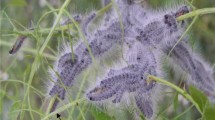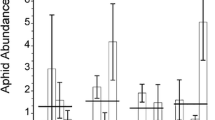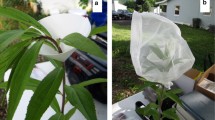Abstract
Gall forming herbivores induce sinks and act as phloem parasites within their host plants. Their performance on the host plant can depend on the sink-source relationship they establish with the plant. Because sink-source relationships within a plant are reflected in its architecture, we examined how architectural differences among cottonwoods might influence the success of the galling aphid, Pemphigus betae. Using cloned cottonwoods in common garden studies, we found three major patterns. First, there is a significant clonal or genetic component to tree architecture; cloned trees grown in a common garden maintain the architecture of parental trees. Second, resistant tree genotypes have more natural sinks (i.e., buds) relative to sources (i.e., stem volume) than susceptible trees. Third, these differences in architecture result in greater competition among sinks on aphid-resistant trees than on aphid-susceptible trees. Sink competition within a tree was estimated by the Gini coefficient which quantifies the size inequality of a shoot population (i.e., competition among sinks is low when shoots are nearly equal in size, and great when a few shoots are large and most are small). Aphid death through gall abortion increased significantly (r 2 = 0.65) on garden-grown trees as competition among sinks within a tree increased. Based on these observations we proposed the “sink competition hypothesis” to account for the performance of gall formers on their host plants. To test this hypothesis, we experimentally reduced sink densities (i.e., buds) on branches of resistant tree genotypes to resemble the bud densities of susceptible genotypes. By reducing the number of competing sinks, we predicted that aphid survival would increase. As predicted, aphid survival significantly increased. For example, in one removal experiment, aphid survival increased from 20% on control branches to 55% on branches with the highest level of bud removal. Similar bud removals on susceptible trees did not increase aphid survival, indicating that competition is relaxed on susceptible hosts. With the exception of the plant vigor hypothesis, most current hypotheses explaining herbivore distributions in nature focus on the importance to leaf-chewing herbivores of variation in chemistry. We believe that a sink competition model is needed to explain the distributions of the diverse group of herbivores that act as phloem parasites. The sink competition model is more mechanistic than the vigor hypothesis, and may account for apparent contradictions because it more clearly quantifies the resource base and the potential interactions that occur when sinks, either herbivore-induced or natural, compete for sources.
Similar content being viewed by others
Author information
Authors and Affiliations
Additional information
Received: 13 May 1996 / Accepted: 29 August 1996
Rights and permissions
About this article
Cite this article
Larson, K., Whitham, T. Competition between gall aphids and natural plant sinks: plant architecture affects resistance to galling. Oecologia 109, 575–582 (1997). https://doi.org/10.1007/s004420050119
Issue Date:
DOI: https://doi.org/10.1007/s004420050119




